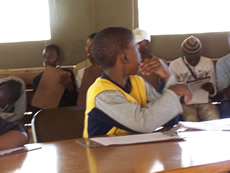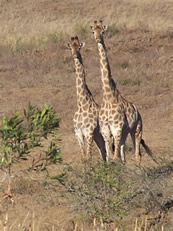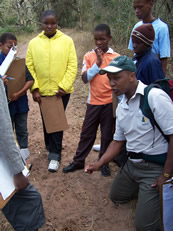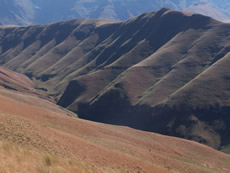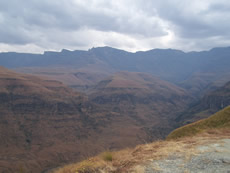
| |
| Home |
| Lanzarote |
| Ireland |
| Wilderness Leadership |
| Zulu Homestay |
| Outward Bound | Photo Galleries |
| contact |
I have just returned from the first part of my placement year out, where I spent 6 weeks working just outside Durban, on a small nature reserve dealing with admin queries, and general help, participating in a wilderness trail, a community environmental education project and as an observer on a Duke of Edinburgh award program. I had the privilege of staying in the old park ranger’s cottage, a basic thatch reed cottage overlooking the Kenneth Stainbank Nature Reserve. The WLS advocates the use of soft facilitation skills to promote the awareness of wilderness areas, and the necessity for them and to maintain awareness of the impact that man has on his environment. The trails are predominantly run in the wilderness area of the Imfolozi Game reserve, in northern Zululand, and consist of 2 wilderness guides and 6 other participants, (max 8 to a group for safety reasons). The wilderness area is home to the big ‘5’, and guides carry rifles, but they are only to be used in extreme situations and as a last resort. Currently the only organisations with the authority to provide a guiding service in the nature reserve are the WLS and the KwaZulu Natal parks board. The trail that I participated on was for 4 days and 3 nights, and after a 3 hour drive, you park at a quarry inside the game park, shoulder your rucksack and walk off into the sunset…literally. You walk in single file, with a guide leading and the second at the rear. It is just like in the films and documentaries you see, where these guys read the spoor, test the wind, and stop constantly to show you animals off to the side of you. Of course, these animals are either so obscurely hidden or insanely far ahead you just gawp at the guides’ amazing eyesight! The aims of the trail are not to walk great distances, or to see as many of the big 5 as possible, rather a more philosophical journey for the individual and a reconnection with nature. Although this being said, you do see a lot of the big 5, and a mass of other animals as well. We only walked 3 kilometres to our overnight stop, which was a series of ledges about 2 metres above ground level, overlooking the White Imfolozi River. Darkness comes quickly, at 17:30 so water and wood collection is a priority on arrival. Since the WLS practise a minimal impact camping philosophy, fires are made on a 10 cm thick, circular, pancake type mound of sand on the ledges, near where you sleep. Since lions and the cat family in general, are a curious bunch, I must dispel the myth that these animals are deterred by fire! Each group has to have a night guard on duty at all times, in order to warn the guides should these cats get too curious or close to camp. On previous trips elephants and rhino’s have wandered through the campsites, hence the recent habitation of ledges. In any case we all took 2 hours, and kept the fire going. It is a very different experience to hear so many different animals, so close and not be able to see them at all! You hear rhino fighting, lions calling, cane rats chewing and the usual call of the hyena as they hunt for a carcass to scavenge. Quite hair raising when you are all alone and every sound is amplified, and your torch won't penetrate further than 3 meters of darkness. In the morning you can see lion tracks and rhino dung within 10 metres of camp! And just to put this in proportion, a lions front poor mark is about the size of one of my hands splayed open. Food for thought...no pun.. On our trip we came across white and black rhino, many wildebeest, impala, crocodile, baboons and elephant and quite a few vultures. In fact we were charged from 40 metres by a sneaky black rhino that was hidden behind an acacia thorn tree. Thank goodness we were able to duck behind a larger bush and move around downwind, so it lost a sense of where we were. We spent the second day tracking the lions that were around our camp the previous night. At times this was hairy in that you are perhaps 50 metres away from a huge lion, that you can't see, yet you know he disappeared into thick reeds along the edge of the river you are hand railing, and the paw prints are still fresh. The rest of the trip was less eventful, but it is a nice feeling to be out in the bush, and to wake in the morning and sit in your sleeping bag and watch the sun rise over the river, and as the sun hits the various trees, the different species of bird start to call. The stars at night were spectacular and alive with shooting stars, the weather was hot in the day, and cooler at night but still not a scratch compared to a UK winter. It is a very special place and I enjoyed my trail tremendously. I also helped out on a community education project where underprivileged kids from a local community are taken out to a smaller nature reserve and complete a mini trail, where they get to see zebra and rhino whilst being educated about resources, alien vegetation, sustainable environmental tourism and just get to be out there and learn. A very well run project and probably more directly beneficial than the wilderness trail itself. It was very enjoyable to work with these young Zulu kids, and to see their enjoyment at being amongst nature.
|
An engaging lesson for the young. Not so for the old in the background..:)
A pair of giraffe's
Explaining how to track animals
A view of the roling hills of the Drakensberg Mountains
Looking towards Monk's cowl |
||||||||
